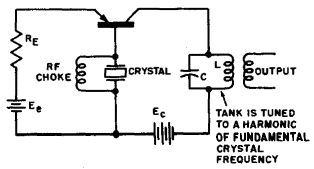| Transistor Basics is a free introductory textbook on transistors and their basic applications. See the editorial for more information.... |

|

Home  Transistor Oscillators Transistor Oscillators  Negative-Resistance Crystal Oscillators Negative-Resistance Crystal Oscillators  Frequency Multiplication Frequency Multiplication |
||






|
||
|
Frequency MultiplicationAuthor: Leonard Krugman
Fig. 6-16. Crystal-controlled frequency multiplier. Proper operation of the frequency-multiplier oscillator requires that the fundamental frequency be rich in harmonics, since low distortion contains little harmonic energy. The inherent non-linearity of negative-resistance oscillators [Figs. 6-9 (A), (B), and (C) ], makes it easy to generate a distorted waveshape. This necessitates the use of a high impedance resonant circuit in the base-controlled oscillator, and the use of a low impedance circuit in the emitter or collector-controlled types. Tight coupling of the base tank also promotes increased harmonic generation, but this feature is generally unsatisfactory because of its adverse effect on frequency stability.
|
||
Home  Transistor Oscillators Transistor Oscillators  Negative-Resistance Crystal Oscillators Negative-Resistance Crystal Oscillators  Frequency Multiplication Frequency Multiplication |
||
Last Update: 2010-11-17


